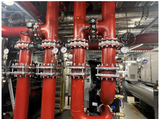What needs to be changed when implementing net zero carbon?
Practical Steps
Implementing net-zero carbon strategies in existing buildings typically involves making various changes to the plant and equipment to improve energy efficiency and reduce carbon emissions. The specific upgrades required will depend on the building's current systems, its condition, and the goals of the net-zero carbon strategy. Here are some common types of plant and equipment that may need to be modified or replaced:
1. Heating, Ventilation, and Air Conditioning (HVAC) Systems:
- Upgrade to high-efficiency HVAC systems.
- Implement zone heating and cooling controls.
- Install heat recovery systems to capture and reuse waste heat.
2. Lighting:
- Replace traditional lighting with energy-efficient LED fixtures.
- Install occupancy sensors and daylight harvesting controls to optimize lighting usage.
3. Building Envelope:
- Improve insulation to minimize heat loss or gain.
- Upgrade windows and doors to increase energy efficiency.
4. Water Heating:
- Replace outdated water heaters with energy-efficient models, such as heat pumps or solar water heaters.
- Implement hot water recirculation systems to minimize water and energy waste.
5. Renewable Energy Sources:
- Install solar panels or wind turbines to generate on-site renewable energy.
- Connect to off-site renewable energy sources through power purchase agreements or green energy procurement.
6. Building Management Systems (BMS):
- Upgrade or install BMS to monitor and control building systems for maximum energy efficiency.
- Implement smart automation for real-time adjustments based on occupancy and weather conditions.
7. Insulation and Air Sealing:
- Retrofit insulation and seal air leaks in the building's envelope to improve energy efficiency and reduce heating and cooling demands.
8. Energy-Efficient Appliances and Equipment:
- Replace older, energy-guzzling appliances (e.g., refrigerators, ovens, and water heaters) with ENERGY STAR-rated models.
9. Water Efficiency:
- Install low-flow faucets, toilets, and showerheads to reduce water consumption.
- Implement water recycling or graywater systems for non-potable water use.
10. Energy Storage:
- Install energy storage systems (e.g., batteries) to store surplus renewable energy and optimize energy use.
11. Combined Heat and Power (CHP) Systems:
- Implement CHP systems to simultaneously generate electricity and capture waste heat for heating or cooling purposes.
12. Transportation Infrastructure:
- If the building has associated parking facilities, consider installing electric vehicle (EV) charging stations or promoting alternative transportation options to reduce carbon emissions from commuting.
13. Energy Management Software:
- Utilize energy management software to track and analyze energy usage, set performance benchmarks, and identify opportunities for improvement.
14. Building Controls and Sensors:
- Upgrade or install advanced building controls and sensors for more precise monitoring and control of various systems, including lighting, HVAC, and water use.
15. Water Treatment and Filtration:
- Implement water treatment and filtration systems to enhance water quality and reduce the need for chemical treatments.
16. On-Site Energy Generation:
- Consider on-site generation options like microturbines or fuel cells for supplementary energy production.
It's important to conduct a comprehensive energy audit and assessment to identify the specific needs of each building and develop a tailored net-zero carbon strategy. The changes required will vary based on the building's location, size, age, and current systems, as well as the budget and timeline for implementation.
